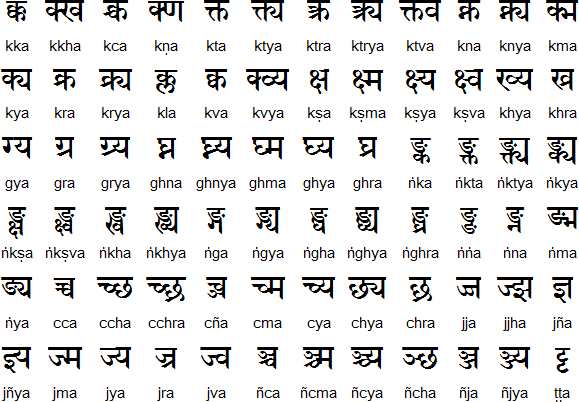सरलं संस्कृतम् प्रथमः पाठः |
සරල සංස්කෘත පාඩම 1
Simple Sanskrit Lesson 1
The Devanagari Script
Introduction
This prelude begins with an introduction to the Sanskrit letters. The writing system used for Sanskrit is known as Devanagari. Indian languages are phonetic in nature and hence the written shapes represent unique sounds. In Sanskrit as well as in other Indian languages, proper pronounciation of the words is quite important. Hence it is necessary to learn the sounds associated with the written shapes.
The word "alphabet" is not usually applied to Sanskrit or other Indian languages. There is a subtle difference between the notion of "alphabet" and the "aksharas" as the letters of Sanskrit are called. When we think of the word "alphabet", we normally think of the name given to each letter to identify it. In most languages the letters of the alphabet have names which may give a clue to the sound associated with the letter. In Sanskrit and other Indian languages, there is no specific name given to the letters. The sound the letter stands for is actually the name for the letter. In a phonetic language, reading becomes easy since the reader will be reading out the words by uttering the sound associated with each akshara. More information on this is given in a separate section on Sanskrit and Phonetics.
For many years now, people of the world have learnt the Aksharas of Sanskrit through equivalent Roman letters which employ special marks (known as diacritics). The diacritics, which consist of marks written above or below a letter of the alphabet, refer to variations in the sound associated with the letter. Dictionaries follow his method to help the reader identify the manner in which the word should be pronounced. In India, the National Library at Calcutta has recommended that a single transliteration scheme be used to represent the Aksharas across all the Indian languages. This scheme will be used in the lessons covered in these pages. Students can take advantage of this when it comes to reading text.
The Roman Letters with Diacritic marks will be introduced along with the Aksharas themselves and hence it is not necessary for the reader to have prior knowledge of the Diacritics. A reference to this Transliteration scheme is also available in a separate page. The scheme is similar to the International Phonetic Alphabet representation but has some minor differences.
The Devanagari Script used for writing Sanskrit and a few other Indian languages has evolved from the Brahmi script which dates back to about 300 B.C. The Devanagari as we see it today, came into use around 1700 A.D. Printing in Devanagari became possible around 1850 after printing presses were establisedin India. The script studied here corresponds to modern Devanagari seen in books printed during the past seventy to hundred years. Books printed in Devanagari prior to 1900 A.D. may show some variations in representing some Aksharas.
The terminology used in classifying the aksharas is fairly standard and conforms to the terminology found in books on linguistics. It is of interest to note that the aksharas had already been classified from a linguistic point of view more than two thousand years ago. Sanskrit is probably the only language which has this distinction.
Sanskrit (संस्कृतम्)
Sanskrit is the classical language of Indian and the liturgical language of Hinduism, Buddhism, and Jainism. It is also one of the 22 official languages of India. The name Sanskrit means "refined", "consecrated" and "sanctified". It has always been regarded as the 'high' language and used mainly for religious and scientific discourse.
Vedic Sanskrit, the pre-Classical form of the language and the liturgical language of the Vedic religion, is one of the earliest attested members of the Indo-European language family. The oldest known text in Sanskrit, the Rigveda, a collection of over a thousand Hindu hymns, composed during the 2nd millenium BC.
Today Sanskrit is used mainly in Hindu religious rituals as a ceremonial language for hymns and mantras. Efforts are also being made to revive Sanskrit as an everyday spoken language in the village of Mattur near Shimoga in Karnataka. A modern form of Sanskrit is one of the 17 official home languages in India.
Since the late 19th century, Sanskrit has been written mostly with the Devanāgarī alphabet. However it has also been written with all the other alphabets of India, except Gurmukhi and Tamil, and with other alphabets such as Thai and Tibetan. The Grantha, Sharda and Siddham alphabets are used only for Sanskrit.
Since the late 18th century, Sanskrit has also been written with the Latin alphabet. The most commonly used system is the International Alphabet of Sanskrit Transliteration (IAST), which was been the standard for academic work since 1912.
Devanāgarī alphabet for Sanskrit
Vowels and vowel diacritics (घोष / ghoṣa)

Conjunct consonants (संयोग / saṅyoga)
There are about a thousand conjunct consonants, most of which combine two or three consonants. There are also some with four-consonant conjuncts and at least one well-known conjunct with five consonants. Here's a selection of commonly-used conjuncts:

Numerals (संख्या / saṇkhyā)

Sample text in Sanskrit

Close me